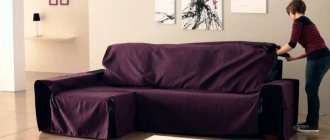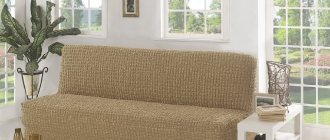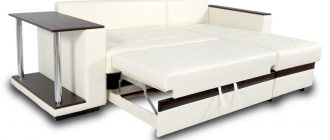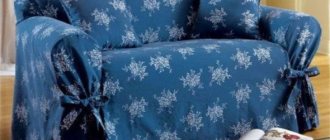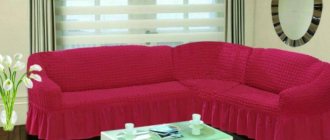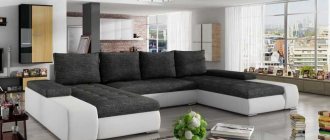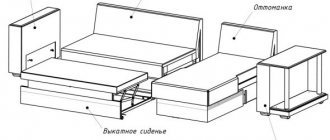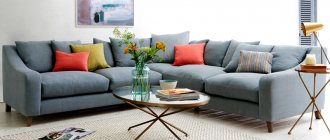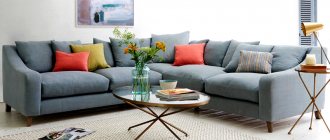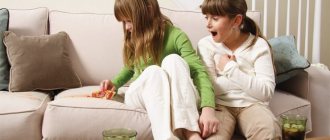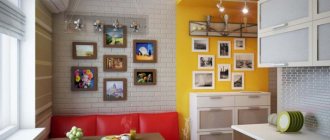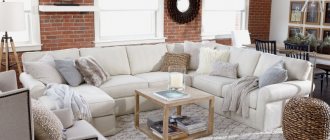Home/Furniture/Sofas/Cover covers for a corner sofa. How to choose and care for covers
A sofa is a large and one of the most noticeable interior items. The corner model looks especially stylish, it is practical, functional, and is a place of constant pastime for all family members, be it a room or a living room. During intensive use, the upholstery quickly becomes dirty and becomes unusable, especially if there are children or animals in the house, so it is important to protect the surface with a special cover for the corner sofa. In addition, a practical cape can change the entire product beyond recognition and add fresh notes to the already boring style of the room.
If you don’t know how to choose the right cover and put it on a corner sofa, the following information is for you.
Features, advantages and disadvantages
The case performs several functions. The main one is protective. It will prevent soiling, wiping, and cracking of the sofa surface. If the furniture reaches the owner in an inappropriate condition, or does not match the design or color scheme, it will hide all the shortcomings and, if chosen correctly, will be in harmony with other furniture elements in the room. In addition, the purchased sofa may go out of fashion or simply become boring - a universal cover will solve this problem.
Note! Buying the best cover will be many times more profitable than buying a new sofa or reupholstering an old one. This is one of the fastest and most practical ways to update your place to sleep and relax.
A wide range of products allows you to choose the best option for a two or even three bedroom model.
A good universal cover for a corner sofa is made of a special elastic fabric consisting of many elastic bands, making it durable, resistant to mechanical stress and dirt, and has an anti-claw function, which is convenient when there is a furry animal in the house.
The covers do not require disassembling the sofa, unlike reupholstery, and are easy to use. Everyone can put it on or take it off for washing.
The disadvantages of using this product are that they hide the original, sometimes interestingly designed surface of the corner sofa, and also the fact that products made from high-quality materials have a fairly high cost.
Types of covers for a corner sofa
Covers can be used to cover both part of the surface of the sofa and the entire product. The first option will be much more budget-friendly, but will not fully protect the upholstery. Solid covers are divided into several types.
Capes
This is a blanket that is tightly secured to the sofa using Velcro, rivets, buttons, decorative ribbons or regular ties. There are also models with zippers. Unlike a regular bedspread, the cape does not come off, does not bunch up and is tightly fixed to the surface. There are several types of such protection: one-piece, like a continuous cover, or separate sheets, each of which covers a different part of the sofa.
With elastic band
The edges are equipped with elastic bands. Such covers with an elastic band are easy to use, look neat, are universal, as they stretch well and will fit on any sofa without armrests, with a right or left indent. You can watch the video on how to put a cover with an elastic band on a corner sofa.
Eurocovers
This is the most practical invention. They are dimensionless, but thanks to the elasticity and resilience of the fabric, they take any shape and are suitable for sofas of any configuration, of any size. Such covers are suitable for types equipped with armrests and for corner sofas without armrests. Produced separately for left- and right-hand sofas. Basically, the fabric chosen for such covers is durable, UV resistant, and easy to wash, so they last for a long period of time.
Rules of care
Caring for the Eurocover is simple and involves following a number of simple recommendations. General care rules:
- Before washing, the product must be turned inside out;
- use the delicate wash mode;
- do not increase the temperature above 40 C;
- do not use softeners or bleaches;
- dry only at room temperature;
- do not iron or steam.
For some models, the manufacturer may indicate a number of additional requirements , which are always specified in the operating and maintenance instructions. You should familiarize yourself with such features in advance.
Style
According to the form they are distinguished:
- Loose - made from any dense material, they successfully hide all the imperfections of the furniture, and are attached with bows or ribbons.
- Falling - secured with ties with Velcro, suggest wavy fabric, draperies, frills, corrugation, as well as other fabric decorations.
- Tight-fitting - stretchable covers for a corner sofa, selected in relation to the size of the furniture; they are dense, stretchy and completely follow the shape of the object for relaxation.
- Particularly dense - generally sewn to order for a specific sofa, the formation of wrinkles and unevenness is completely eliminated, ideally emphasizing the original shape and contours of the sofa.
The style is selected based on the model of the sofa and the preferences of the owner.
It is worth paying attention: the more elaborate the shape of the cover, the more combinations of fabrics, decor in the form of buttons, beads, the greater the likelihood that these parts and elements will fall off, break off, and can ruin the appearance of the product.
A cover without a skirt for a corner sofa will be a universal option.
The cover is secured using:
- Locks and zippers - almost invisible, or, on the contrary, massive, brightly and contrastingly highlighted to give a certain style.
- Ties, which are used as ribbons, lace, original laces. Suitable for free-fall covers.
- Buttons and snaps that securely secure the cover to the mattress.
- Elastic bands that frame the edges of the cover for the corner sofa.
- Velcro – the soft side of which is fixed on the cover, and the hard side is attached to the sofa.
Dimensions
As a rule, corner sofas are large and massive, and when unfolded they become even more bulky. This accessory is selected depending on the size of the sofa - for children's models the length of the berth does not exceed 150 cm, sofas for adults are made 2-2.1 meters. The most common model is considered to be 200 by 380 mm in size.
Owners of custom-made sofas with non-standard dimensions are recommended to purchase a universal cover, but when choosing, it is worth considering not only the length of the berth, but also the height of the backrest, the presence of armrests, and the side of the protrusion. Beautiful new covers for a corner sofa can be seen in the photos published on the websites of furniture stores and accessories.
Materials
The material from which the case is made directly affects its service life, wear resistance, appearance, and cost.
When choosing a material, you should pay attention to how often the sofa is used as a sleeping place, how many children there are in the house, whether there are pets, and how often the owner receives guests. Depending on this, sellers will recommend durable, non-fading, non-staining, ready for constant washing, not prone to puffs or stains, presentable, original colors and other options. It is also worth considering the environmental factor. If the sofa is intended for a child or is used every day as a bed, it is better that the cover is made of natural textiles.
The most popular and frequently purchased are:
- Flock - feels like soft velvet; this cover is suitable for permanent versions of corner kitchen sofas or those located in the living room. This is a durable fabric made from cotton fibers diluted with synthetic additives. Flock does not harbor dust mites, is resistant to sunlight, and does not fade. The only drawback is that the fabric can cause allergies in people prone to such pathologies.
- Velor is also reminiscent of velvet, but has a much lower price. This textile is made from different types of raw materials, with different pile arrangements, which affects its properties, as well as its appearance. Velor does not cause allergies and is stain resistant.
- Cotton is a natural, environmentally friendly fabric that lends itself well to dyeing, so you can create models of a wide variety of colors from it. The fabric does not contain synthetic additives, due to which it has a very short service life and can shrink after washing. This option is recommended for children, citing its naturalness and natural origin.
- Microfiber is the most popular type for Euro covers. This is a modern, durable fabric that will last for many years without requiring special care. Resistant to ultraviolet rays, stains of any type are easily removed from the surface. With the addition of Teflon it becomes even more durable and durable.
- Chenille is a soft, warm fabric. Acrylic in the composition makes it almost airy. Sofas upholstered in chenille look impressive and are pleasant to touch. The textiles tightly fit the structure of the sofa, so it is not suitable for old sagging models, the shortcomings of which cannot be hidden.
Attention! Glue-based chenille is harmful and is also inferior in quality to analogues. Therefore, before choosing such fabric, it is advisable to clarify its properties and origin with the seller.
- Jacquard - thanks to the elastane and polyester in its composition, it is not subject to deformation. In addition, it consists of natural cotton fibers. Ideal for rooms designed in classic and traditional styles. The material is durable and difficult to damage or tear. An indispensable option for owners with animals.
- Eco-leather is a budget analogue of natural fabric. This case looks presentable and is also suitable for families with children, thanks to its ease of care. Dirt stains can be easily wiped with a cloth. The anti-vandal type will last longer and will be more resistant to mechanical stress. This cover will also fit well on a kitchen corner sofa.
- Nubuck - looks presentable, is expensive, pleasant to the touch. Suitable for a buyer with a tight wallet. It is more difficult to care for such material: daily dry cleaning with a vacuum cleaner is required, stains can only be removed with a special product. In addition, you need to purchase a set of sponge, foaming agent, sprayer, and rubber brushes that will help with cleaning.
In addition, tapestry, brocade, corduroy, teak, damask, as well as the new relax product are used in the production of these accessories - they look like leather, do not absorb water, are not subject to puffing, and are moisture resistant.
What are they made from?
Manufacturers use different technologies and materials . The number of fabric series used today is about 10. Most often used for sewing:
- jacquard;
- chinilla;
- pleated;
- microfiber.
Jacquard consists of cotton, polyester and elastane . The advantage of the material is its strength, and the weaving of elastic threads provides good stretchability. It is recommended to purchase covers made of such fabric if necessary to protect furniture from animals, since the material is not afraid of the claws and teeth of pets. As a rule, the jacquard surface has a three-dimensional pattern, so it is ideal for use in a classic interior.
The chinilla covering is dense and soft, resembling plush in appearance. Elastic bands are woven in the longitudinal and transverse directions, which ensures good stretchability. The fabric contains acrylic, which is why these Euro covers are lightweight.
European pleated products are ideal for protecting furniture from pets. The corrugated surface of the cover has a spring effect, which scares off pets when they try to sharpen their claws. Microfiber products have the best stretchability.
The advantages of all materials from this list are ease of washing, no need for ironing, ability to retain their shape and basic characteristics for a long time.
Price
The cost of the covers is directly affected by the textiles used in production, the reputation of the manufacturing company, and the number of decorative elements.
Thus, an Italian-made cotton cover for a corner sofa with a protrusion on the right will cost 11.5 thousand rubles, and a Turkish stretchable model consisting of cotton and polyester will cost half as much.
A nice soft cover made of elastane and polyester, sewn in Spain, costs 5.5 thousand rubles for a corner sofa with a ledge on the left.
An Italian cover for a sofa without armrests made of synthetic fabrics costs 6.5 thousand rubles, and for an Italian model with microfiber elastic you will have to set aside more than 14 thousand rubles.
Domestic manufacturers will charge 8.5 thousand rubles for a cotton cover.
Caring for cases
Caring for this universal cape is one of the main advantages of this product. Thanks to the design, they can be easily removed, washed and put back on. It is recommended to wash it at least twice a year, depending on the color and material.
During general cleaning, you can also vacuum the cover once every week or two to avoid dust accumulation.
In order to be able to care for the new cover, you first need to find out how to put it on a corner sofa.
Types of European cases
There are three main types of coverings available for different sofa models.
Covers can be:
- double;
- triple;
- corner.
The modification of the cover is determined in accordance with the measurements taken of the length of the back of the furniture (from the right edge to the left).
How to measure a sofa
Important! The accuracy of the measurements is not important. You can even estimate the size by eye.
Table. Types of European covers depending on the length of the sofa.
| Sofa back length, mm | Case model |
| 1200…1600 | Double |
| 1600…2450 |
|
| 3800…5500 |
|
In addition to the listed types, we can produce covers for chairs, for sofas that do not have armrests, as well as for furniture upon special order.
Corner sofas can be right- or left-handed. This is important when purchasing a product.
How to put on a cover
These protective capes are often made of elastic, stretchable materials, so choosing the optimal size is not difficult. How to put a cover on a sofa? The process of putting a cover on a corner sofa consists of several points:
- The product must be moved away from the wall to gain maximum access to it, and the cover must be laid out according to all corners of the structure.
- Next, they begin to stretch the material according to the instructions included in the kit onto the surface of the sofa.
- The cover is carefully straightened, it is attached from below and from above, while voids are formed in the seat area, which can be eliminated by inserting gaskets into the cracks between the back and seat.
- After finishing the work, the sofa is pushed back into the corner.
The process is quite simple, so it does not require a significant investment of time and effort.
You can learn how to put a cover on a corner sofa with an elastic band by watching the corresponding video instructions.
How to put on the case
The elastic covering can be stretched over the sofa in a few minutes.
Included with the case, the manufacturer usually provides detailed instructions for fixing the product. The work technology includes several stages.
How to put on the case
Step 1.
The sofa moves away from the walls. It is necessary to provide access to all its elements.
Step 2.
The product removed from the packaging is laid out on the sofa.
The product is laid out on the sofa
You need to find the shortcut
Step 3.
The cover is put on the back, after which it is fixed on the armrest (you can start work from any side) and straightened out on it.
The cover is pulled onto the armrest
The fabric must be positioned correctly
Step 4.
The entire back of the sofa is closed.
The cover is pulled over the back and the second armrest
Step 5.
The covering is put on the second armrest.
Step 6.
The seams of the cover are tucked into the gap between the armrest and the seat.
The seams of the cover are tucked into the gap
Step 7.
In the same way, the material is tucked into the recess between the back and the seat along its entire length.
The seams of the cover are tucked between the seat and backrest
Close-up photo
Step 8.
The fabric on the second armrest is straightened and aligned in the same way.
The fabric is also tucked in on the first armrest
Step 9.
The fabric is stretched to cover all visible parts of the piece of furniture.
The cover should hide the upholstery of the sofa
Step 10.
To tighten the textiles in the central part, a special fixing tape is used, which is attached to the edge of the fabric (in the corner) and passed under the sofa.
Fixing tape
On the back side, the fastener also clings to the cover with a clip.
Using a retainer
Step 11
In order for the material to be better fixed in the recess between the seat and the back, gaskets are used, which can be made of foamed polymer or corrugated cardboard folded into a triangular structure.
Spacers or holders for the recess between the seat and the back
The holders are placed inside one at a time, tightly fixing the fabric. With the help of such simple devices, the cover will not crawl out of the cracks, even if the children are frolicking.
Using holders
Step 12
The covering is finally smoothed so that it exactly follows the contours of the sofa.
The cover is placed on the sofa.
The upholstered furniture has received a new look and will be able to delight the owners with its attractive appearance for a long time.
The emergence of new technologies and materials makes it possible to extend the life of interior items without making special efforts to do so.
Chair covers
Results
A cover for a corner sofa is a universal and practical protection, easy to care for and use. It will not only stand in the way of dirt, stains and deformations of the surface of the product, but will also give the room a new look, become an original design, and complement the existing design. A sofa “dressed” in a cover will last longer and will maintain a presentable appearance for many years.
Some nuances
No matter how durable and stain-resistant the products are, care is necessary. Products can be washed in washing machines at a temperature of 300 to 400 rpm. No spinning is performed. Products are not ironed or steamed. In some products the skirt is steamed.
To select the right cover for your sofa, you need to take measurements. This is quite easy to do. It is enough to measure the length of the back and compare it with the degree of stretch of the product.
